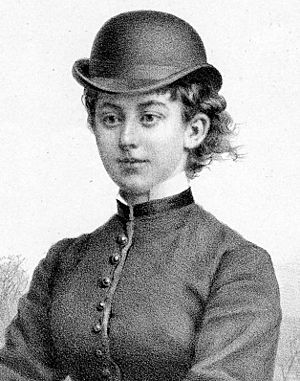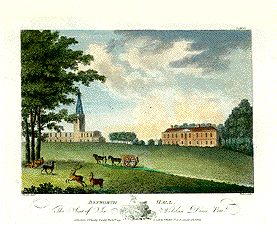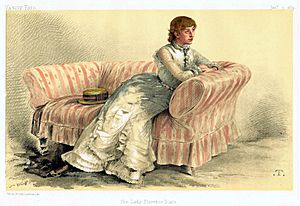Lady Florence Dixie facts for kids
Quick facts for kids
Lady Florence Dixie
|
|
|---|---|

Illustrated portrait of Dixie, c. 1880
|
|
| Born |
Florence Caroline Douglas
24 May 1855 Cummertrees, Dumfriesshire, Scotland
|
| Died | 7 November 1905 (aged 50) Glen Stuart, Dumfriesshire, Scotland
|
| Nationality | Scottish |
| Occupation | War correspondent |
| Known for | Feminist |
| Spouse(s) |
Alexander Dixie
(m. 1875) |
| Children |
|
Lady Florence Caroline Dixie (born Douglas; 24 May 1855 – 7 November 1905) was an amazing Scottish writer, war correspondent, and a champion for women's rights. She wrote about her adventures in Across Patagonia. She also wrote children's books like The Young Castaways and Aniwee; or, The Warrior Queen. Her book Gloriana; or, The Revolution of 1900 was a story about a perfect world where women had equal rights. All her books explored important ideas about girls, women, and their place in society.
Contents
Early Life and Adventures
Lady Florence Douglas was born in Cummertrees, Scotland, on 24 May 1855. Her parents were Caroline Margaret Clayton and Archibald Douglas, the 8th Marquess of Queensberry.
Florence had a twin brother, Lord James Edward Sholto Douglas. She also had an older sister, Lady Gertrude Douglas, and three older brothers: John, Francis, and Archibald.
Florence was known as a "tomboy". She loved to swim, ride horses, and hunt, just like her brothers. She rode horses in a way that was unusual for girls at the time. She also wore her hair short and didn't follow the latest fashion trends. She was very close to her twin brother James. She was also much like her older brother John, being "fearless, dynamic and opinionated".
Her childhood had some difficult moments. When she was seven, her mother moved Florence and her two youngest brothers to France. This was so she could raise them in the Catholic faith. After two years, they returned to England. Florence was taught at home by a governess. She later went to a convent school, which she did not enjoy. But she found comfort in writing poetry. Her childhood poems were later published under the name 'Darling'.
A sad event happened when Florence was ten. Her brother, Lord Francis Douglas, died while climbing the Matterhorn mountain in 1865. He was only 18. This was a huge tragedy for her family and was reported worldwide. Years later, Florence visited the Matterhorn with her brother John. He showed her where Francis had died.
Marriage and Family Life
On 3 April 1875, when she was 19, Florence married Sir Alexander Beaumont Churchill Dixie, 11th Baronet. He was known as "Beau". Beau had a large income and owned a country house called Bosworth Hall. He also had a townhouse in London.
Even though Florence was shorter than Beau, she was the stronger partner in their marriage. People said she "ruled her husband with a rod of iron".
They had two sons: George Douglas (born 1876) and Albert Edward Wolstan (born 1878). Albert's godfather was the Prince of Wales.
Florence and Beau both loved adventure and being outdoors. They had a happy marriage. However, Beau's financial difficulties led to their family home, Bosworth Hall, being sold in 1885. After this, they moved to Glen Stuart in Scotland. This house was on her brother Lord Queensberry's estate.
Writing Adventures
In 1877, Lady Florence published her first novel, Abel Avenged: a Dramatic Tragedy. Many of her books, especially her children's stories like The Young Castaways and Aniwee, explored ideas about women's roles in society. Her adult novels, Gloriana and Isola, also focused on these themes. Her last novel, The Story of Ijain, was published in 1903.
Lady Dixie is best known for her travel books. These include Across Patagonia (1880) and In the Land of Misfortune (1882). In these books, she wrote about her own experiences. She became the main character of her stories. This was a new way for women to write travel books back then.
Exploring Patagonia
In December 1878, Lady Dixie and her husband traveled to Patagonia. This was just two months after their second son was born. She was the only woman in her group. Her brothers, Lord Queensberry and Lord James Douglas, and a family friend named Julius Beerbohm joined them. Beerbohm was their guide. Florence chose Patagonia because few Europeans had ever been there.
In her book Across Patagonia, Dixie described the wild landscape. She showed how strong and brave you needed to be to survive there. She acted "active, hardy, and resilient". This went against the idea that women were weak and needed protection.
In her book, she rarely mentioned her husband by name. She presented herself as the hero of the trip. She often wrote about how she was as good as, or even better than, the men in her group.
Lady Dixie shared her observations about Patagonia with Charles Darwin. She disagreed with his description of the Tuco-tuco animal. Darwin thought they were mostly underground at night. But Lady Dixie had seen them out during the day. She sent Darwin a copy of her book.
When she returned from Patagonia, Dixie brought home a jaguar as a pet. She named it Affums. Affums caused some trouble by killing deer in Windsor Great Park. So, it had to be sent to a zoo.
A hotel in Puerto Natales, Chile, is named the Hotel Lady Florence Dixie in her honor. Her adventures in Patagonia inspired her later writing. They also influenced her work for women's rights. Her two children's books, The Young Castaways and Aniwee, are set in Patagonia. They feature strong female characters.
Reporting from South Africa
In 1881, Dixie became a war correspondent for the Morning Post newspaper in London. She went to South Africa to report on the First Boer War (1880–1881). She also covered what happened after the Anglo-Zulu War. She and her husband traveled there together. She visited Zululand and interviewed the Zulu king Cetshwayo. He was being held by the British.
Her reports and books helped King Cetshwayo get his throne back briefly in 1883. In her book In the Land of Misfortune, she showed sympathy for the Zulu people. But she also remained loyal to the British Empire.
A Vision for Women's Rights
Lady Dixie strongly believed in equal rights for women. She thought that men and women should be equal in marriage and divorce. She also believed that the oldest child should inherit the throne, no matter if they were male or female. She even thought men and women should wear similar clothes. She was a member of the National Union of Women's Suffrage Societies. This group worked for women's suffrage (the right to vote). Her obituary said she "threw herself eagerly into the Women's Movement".
In 1890, Dixie published a novel called Gloriana, or the Revolution of 1900. This book is a feminist fantasy. In the story, women win the right to vote. This happens because the main character, Gloriana, pretends to be a man named Hector D'Estrange. She gets elected to the House of Commons. The book also features other strong women. One character, Lady Flora Desmond, helps create a 200,000-member Women's Volunteer force. She even leads an elite mounted White Regiment.
The book ends in 1899. It describes a successful and peaceful Britain. Its government has greatly benefited from women's involvement. In the book's introduction, Dixie suggested that boys and girls should be educated together. She also believed that all jobs and positions should be open to both sexes.
Women and Sports
Women's Football
Lady Dixie played a big part in starting women's association football. She organized games to raise money for charity. In 1895, she became President of the British Ladies' Football Club. She wanted the girls to play with "heart and soul". She even arranged for a women's football team from London to play in Scotland.
Changing Views on Hunting
In her younger days and during her travels, Dixie loved sports like riding and hunting. Her riding skills were so good that they were mentioned in sports magazines. In Patagonia, hunting was important for the group's survival. Dixie shared the responsibility and dangers of finding food.
However, her feelings about hunting changed. She felt "sad remorse" after hunting a beautiful, trusting deer. In the 1890s, her views on field sports changed a lot. In her 1891 book The Horrors of Sport, she said that blood sports were cruel. Lady Dixie later became Vice-President of the London Vegetarian Association.
Politics and Public Life
Lady Dixie often wrote letters to newspapers. She supported liberal and progressive ideas. This included supporting Scottish and Irish Home Rule. Her article The Case of Ireland was published in Vanity Fair in 1882.
She was critical of some Irish political groups. There were reports of an attack on her in March 1883. This incident received international attention. However, many people doubted if the attack actually happened.
Death
Lady Florence Dixie died from diphtheria on 7 November 1905. She was buried next to her twin brother on the Kinmount estate. The New York Times reported her death. They called her an "Author, Champion of Woman's Rights, and War Correspondent".
Likenesses
A black and white picture of Dixie was made in 1877. It shows her on horseback. A copy is in the National Portrait Gallery.
A more famous colored picture of her was in Vanity Fair magazine in 1884. This magazine featured drawings of important people. Out of over two thousand people shown, only eighteen were women. Lady Dixie was one of these special women.
Descendants
Lady Florence Dixie's oldest son, George Douglas Dixie (1876–1948), served in the Royal Navy. He later became a captain in the army. In 1924, he became the 12th Baronet after his father died.
When Sir Douglas died in 1948, his son, Sir (Alexander Archibald Douglas) Wolstan Dixie, became the 13th and last Baronet. He had two daughters, Eleanor and Caroline. Both daughters have children.





